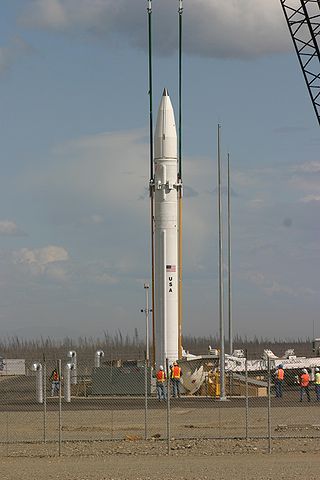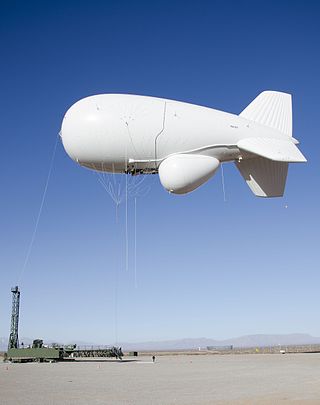
An anti-ballistic missile (ABM) is a surface-to-air missile designed to counter ballistic missiles. Ballistic missiles are used to deliver nuclear, chemical, biological, or conventional warheads in a ballistic flight trajectory. The term "anti-ballistic missile" is a generic term conveying a system designed to intercept and destroy any type of ballistic threat; however, it is commonly used for systems specifically designed to counter intercontinental ballistic missiles (ICBMs).

In military terminology, a missile is a guided airborne ranged weapon capable of self-propelled flight usually by a jet engine or rocket motor. Missiles are thus also called guided missiles or guided rockets. Missiles have five system components: targeting, guidance system, flight system, engine and warhead. Missiles come in types adapted for different purposes: surface-to-surface and air-to-surface missiles, surface-to-air missiles, air-to-air missiles, and anti-satellite weapons.

The Strategic Defense Initiative (SDI), derisively nicknamed the "Star Wars program", was a proposed missile defense system intended to protect the United States from attack by ballistic strategic nuclear weapons. The concept was announced on March 23, 1983, by President Ronald Reagan, a vocal critic of the doctrine of mutually assured destruction (MAD), which he described as a "suicide pact". Reagan called upon American scientists and engineers to develop a system that would render nuclear weapons obsolete. Elements of the program reemerged in 2019 with the Space Development Agency (SDA).

National missile defense (NMD) is a generic term for a type of missile defense intended to shield an entire country against incoming missiles, such as intercontinental ballistic missile (ICBMs) or other ballistic missiles.

The RCA 474L Ballistic Missile Early Warning System was a United States Air Force Cold War early warning radar, computer, and communications system, for ballistic missile detection. The network of twelve radars, which was constructed beginning in 1958 and became operational in 1961, was built to detect a "mass ballistic missile attack launched on northern approaches [for] 15 to 25 minutes' warning time" also provided Project Space Track satellite data.

Ground-Based Midcourse Defense (GMD) is the United States' anti-ballistic missile system for intercepting incoming warheads in space, during the midcourse phase of ballistic trajectory flight. It is a major component of the American missile defense strategy to counter ballistic missiles, including intercontinental ballistic missiles (ICBMs) carrying nuclear, chemical, biological or conventional warheads. The system is deployed in military bases in the states of Alaska and California; in 2018 comprising 44 interceptors and spanning 15 time zones with sensors on land, at sea, and in orbit. In 2019, a missile defense review requested that 20 additional ground-based interceptors be based in Alaska.

Missile defense is a system, weapon, or technology involved in the detection, tracking, interception, and also the destruction of attacking missiles. Conceived as a defense against nuclear-armed intercontinental ballistic missiles (ICBMs), its application has broadened to include shorter-ranged non-nuclear tactical and theater missiles.

The Sea-Based X-Band Radar (SBX-1) is a floating, self-propelled, mobile active electronically scanned array early-warning radar station designed to operate in high winds and heavy seas. It was developed as part of the United States Department of Defense Missile Defense Agency's (MDA) Ballistic Missile Defense System.

The A-135 is a Russian anti-ballistic missile system deployed around Moscow to intercept incoming warheads targeting the city or its surrounding areas. The system was designed in the Soviet Union and entered service in 1995. It is a successor to the previous A-35, and complies with the 1972 Anti-Ballistic Missile Treaty.

The S-500 Prometey, also known as 55R6M "Triumfator-M", is a Russian hypersonic surface-to-air missile/anti-ballistic missile system replacing the A-135 missile system currently in use, and supplementing the S-400. The S-500 was developed by the Almaz-Antey Air Defence Concern. Initially planned to be in production by 2014, the first unit entered service in 2021 with the 15th Air Army.

Dunay radar was a system of two Soviet radars used to detect American ballistic missiles fired at Moscow. They were part of the A-35 anti-ballistic missile system. One sector of one of the radars, the Dunay-3U is still operational and is run by the Russian Space Forces as part of the Main Control Centre of Outer Space.

The Sky Bow, or Tien Kung, are a series of surface-to-air anti-ballistic missile and anti-aircraft defense systems developed by Taiwan. The TK-2 and TK-3 are in service with the Military of the Republic of China.

The AN/SPY-6 is an active electronically scanned array 3D radar under development for the United States Navy (USN). It will provide integrated air and missile defense for Flight III Arleigh Burke-class destroyers. Variants are under development for retrofitting Flight IIA Arleigh Burkes and for installation aboard Constellation-class frigates, Gerald R. Ford-class aircraft carriers, and San Antonio-class amphibious transport docks.

The 5N65 radar was a Soviet military phased array radar initially designed for the S-225 anti-ballistic missile system which was never commissioned. The radar was later installed near the Kura Test Range in Kamchatka in the Russian Far East as a part of 5K17 tracking and measuring system and was demolished in 2006.

The Ground Master 400 is a mobile long range radar system manufactured by Thales. GM400 is a fully digital active electronically scanned array long-range air defense 3D radar, offering detection from very high to very low altitudes. It tracks a wide range of targets from highly maneuverable tactical aircraft flying below several hundred feet to the unconventional small radar cross section devices, such as UAVs or cruise missiles.

Launch Complex 38 was the White Sands Missile Range facility for testing the Nike Zeus anti-ballistic missile. The site is located east of the WSMR Post Area.

The Joint Land Attack Cruise Missile Defense Elevated Netted Sensor System, or JLENS, was a tethered aerial detection system designed to track boats, ground vehicles, cruise missiles, manned and unmanned aircraft, and other threats. The system had four primary components: two tethered aerostats which utilized a helium/air mix, armored mooring stations, sophisticated radars, and a processing station designed to communicate with anti-missile and other ground and airborne systems. Each system was referred to as an "orbit", and two orbits were built. The Army-led joint program which fielded JLENS was designed to complement fixed-wing surveillance aircraft, saving money on crew, fuel, maintenance and other costs, and give military commanders advance warning to make decisions and provide notifications. Following cost overruns, underperformance, declining support in Congress, and public scrutiny following a snapped tether which allowed one craft moored at Aberdeen Proving Ground, Maryland to drift on a 100-mile uncontrolled descent across Pennsylvania, dragging its cable tether which damaged power lines and cut power to 20,000 homes, the program was suspended in October 2015, and completely discontinued by 2017.
The Long Range Discrimination Radar(LRDR) that is planned for operational service in Alaska in 2020 is part of the United States's Ground-Based Midcourse Defense anti-ballistic missile system. The main contractor is Lockheed Martin, under a US$784 million contract from the Missile Defense Agency in October 2015.

The AN/TPY-2 Surveillance Transportable Radar, also called the Forward Based X-Band Transportable (FBX-T) is a long-range, very high-altitude active digital antenna array X band surveillance radar designed to add a tier to existing missile and air defence systems. It has a range of 2,900 mi. Made by Raytheon, it is the primary radar for the Terminal High Altitude Area Defense (THAAD) missile system, but also cues the AN/MPQ-53 radar of the MIM-104 Patriot system. Patriot PAC-3 is a lower-altitude missile and air defense system than THAAD.
















